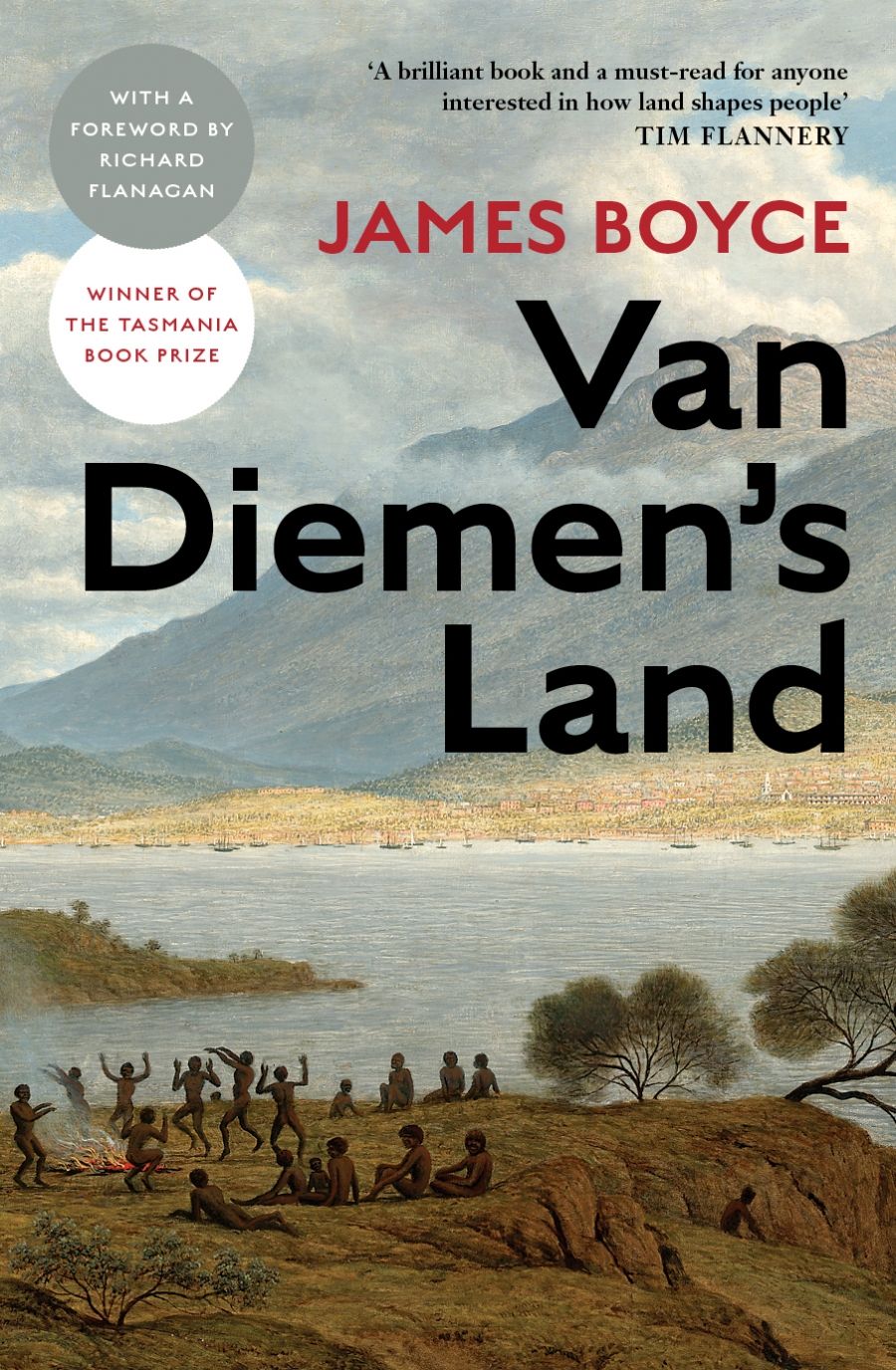
- Free Article: No
- Contents Category: Australian History
- Custom Article Title: The Dreaming Place
- Review Article: Yes
- Article Title: The Dreaming Place
- Online Only: No
- Custom Highlight Text:
Henry Lawson epitomised the weather-beaten laconic when he said: ‘Death is about the only cheerful thing in the bush.’ A century later, Bill Bryson, in Down Under (2000), picked up where Lawson left off: he defined the ‘real Australia’ as places where ‘no sane person would choose to live’. Somewhere in between, Patrick White created one of those dubious entities, a sweat-stained eccentric in an undaubed slab hut who told the explorer Voss that the country ahead of him was all stones and thorns, a place where anyone crazy enough to go out there might celebrate a ‘high old Mass ... with the skull of a blackfeller and his own blood’.
- Book 1 Title: Van Dieman's Land
- Book 1 Biblio: Black Inc., $49.95 hb, 388 pp
- Book 1 Cover Small (400 x 600):

- Book 1 Cover (800 x 1200):

Abundance is the lynchpin of James Boyce’s fine history of early Van Diemen’s Land. The book, as I read it, is of three parts: the first, the untamed years, covering 1803-23, when abundance unravelled established hierarchies and expectations, permitting the most unlikely liberties, bestowing power on the poor, and giving rise to unexpected and troubling alliances between white and black. The second part is about the end of all that, and the taming or civilising of Van Diemen’s Land with the coming of the free settlers and the imposition of familiar property relations (getting abundance under control, we might say) and the emergence of what some have called a ‘Little England’ – the building of grand estates around elaborate Georgian homesteads, the restoration of ‘proper’ hierarchies and the deference required to sustain them. This takes the book from 1824 to 1856, the year in which responsible government was ceded to ‘Tasmania’, a name to signify how to remember and what best to forget. The third part is a long appendix on government policy and the Aboriginal people, 1827–38.
Boyce’s first target is the myth of ‘Little England’, the idea that Van Diemonian society began with the influx of the free settlers in the 1820s, before which there was only a penal colony, a wilderness and barbarism. This, of course, was the settlers’ story, and they quickly found the scribes and chroniclers they required to set it down as ‘fact’. Boyce has a piercing eye. His principal achievement in Van Diemen’s Land is the way he cuts through this myth, transcending the judgmentalism to show us, in sometimes fascinating detail, a pre-modem world, a fragile, contingent way of life, something that could never last, never hold out against modernity and the marketplace. Yet for that brief ‘moment’, for twenty years or so, there was a society – loose and impromptu, defiant, independent, contrary – and Boyce’s significant achievement is the telling of how it worked and how it was so quickly unravelled and scotched (no, barred) from the national story.
Firstly, the scale must be considered. There were only 1321 Europeans in Van Diemen’s Land in 1810; still only 1953 in 1815, and about 4500 at the beginning of 1820. Abundance is relative, but with these numbers it was easy and possible for a time to share the land with the indigenous peoples who, as Boyce tells us, had been there for three times longer than Homo sapiens in Britain.
Necessity shaped unconventional solutions. In the first few years of settlement, the convicts and officers, military and civil, despaired of England ever sending more supplies. The answer was a ‘kangaroo economy’ or kangaroo-meat economy, to be more precise. Hunters, like George Harris, soon realised the abundance there for the taking and it took no time at all for a ‘hinter’ world to establish itself: a simple, rustic world, largely self-sufficient and beyond the discipline of market relationships; thus, a worry to authorities. This was the wild world that so horrified respectable observers and later worthies who looked back and shuddered.
Britons outside the settlements were soon living ‘a way of life somewhat resembling that of the Aborigines’, writes Boyce. They were hunters, or hunter-graziers (or bushrangers), in a wilderness unfenced and untenanted, as if Van Diemen’s Land was a giant English common. And so, ironically, something of a ‘Little England’ did exist before the respectable, propertied and well-scrubbed free settlers – the underwear and socks brigade – arrived. But this was the other ‘Little England’, the one that E.P. Thompson wrote so well about: that eighteenth-century world of ‘customary consciousness and customary usages’, an undisciplined plebeian culture that lived simple, thumbed its nose at piety, obeyed the seasons at least, if not the master, and no more wanted innovation or efficiency (is enough not enough?) than a sane man wanted rats in his barn or bats in his belfry.
We are reminded of how escapees in New South Wales wanted to get out of that colony, to China perhaps, or back to England, or anywhere. In Hobart Town and Port Dalrymple, writes Boyce, ‘the dreaming place was the heart of Van Diemen’s Land itself’.
Boyce’s exploration of the startling possibilities that arise from abundance is thematic. Dear Reader, he says, let me take you to a locale where a good hunting dog (the wolfhound-greyhound cross preferred) was akin to gold. Share the dog’s progeny with the tribes you encounter and in all probability they will share the land with you (for a time), for hunting dogs in kangaroo and emu country were a currency to cut across the vastness of the cultural divide. Note, too, that there will be room for cattle and sheep on the open grasslands, that a kind of coexistence will prevail for a decade or two, so ‘co’ that soon you’ll see the Europeans living in crude, makeshift huts of sapling and bark, wearing kangaroo skin jackets and hats and possibly moccasins secured with sinews taken from the hind or ‘hopping’ quarters.
The span here is considerable. Boyce’s account of economic relationships ( e.g., the trade in dogs, subsistence farming, barter) is complemented by sallies into the moral economy ( e.g., marriage and morality, music and the pub, wine, women, and song).
The Rousseauan temptation to idealise a simple, premodern world is ingrained here, and enticing, but Boyce never falls for it. He has too sharp an eye for the hard pragmatic realities, and for the inevitable limits, the most obvious one being the uneasy peace between black and white: from the outset, shared land use was never entirely free from outbreaks of violence, notably the cruelties perpetrated upon the Aboriginal people by bushrangers.
For the authorities, the problem of abundance permitted too many to live beyond the law and others to thrive in defiance of it. By 1815 bushranging was endemic and martial law followed. Here, too, Boyce explores the relationships that sustained the bushrangers, links or ‘understandings’ with self-interested parties in the settlements and with black authority in the hinterland. Boyce leans to the ‘social banditry’ model. Nineteenth-century Sicily comes to mind, with its criminal bands, knitted into the community with a nod and a wink or a whiff of menace or a shot of lead.
The second part of the book, the coining of ‘Little England’, is much more familiar territory and similarly holistic in its coverage of the new settler economy, the destruction of Aboriginal society, the imposition of discipline and dependence upon convicts and free workers alike, a new political order dominated by the large landowners and the fate of the land once the indigenous people were killed or shipped off.
Then there is the appendix: fifty-two pages organised into three chapters and called ‘Towards Genocide: Government Policy on the Aborigines 1827-38’. Why this was not edited down and incorporated into the main part of the book is a mystery. The main part includes a substantial chapter called ‘Fighting the Aborigines’, dealing with the end of coexistence, the expanding war and its phases, some aspects of policy, the fear of fire, the problems of terrain, all culminating in confinement and exile (and near annihilation) by 1838. One of the oddities .that follow from the separation of text proper and appendix is a text with no mention of the Black Line, Governor Arthur’s notorious attempt to drive the Aborigines east of Hobart Town into permanent captivity on the Tasman Peninsula. That event is relegated to the back shed. Other fascinating bits of policy detail are, likewise, consigned to the rear of the book, as is the treacherous emissary and ‘peacemaker’, George Robinson. Robinson was an exceptionally important player in the story yet he doesn’t really materialise until it is virtually over.
If government policy is part of the story, it should be worked into the book, not tacked on at the end; otherwise it seems like unfinished business. The density and the policy-focused detail of the appendix are out of kilter with the expansive, survey style of the book as a whole. That is probably why it doesn’t fit in its present form. Perhaps it is the beginnings of another book? Let’s hope so.
In the meantime, Boyce has made a major contribution to our understanding of the destruction of Aboriginal society in Van Diemen’s Land. His account of the fighting takes the reader through two phases of the war against the socalled blacks. It is a chilling tale marked first by the ‘easy slaughter’ of slow and vulnerable clan groups when Aboriginal society was still intact; then, from 1828, by the chasing down of the remnants, the warrior bands who fought on, a chase facilitated in no small measure by knowledge acquired in the coexistence phase. In less than twenty years, Aboriginal society was. destroyed by dispersion, random slaughter and enforced exile. There is no discussion of the title phrase ‘Towards Genocide’ here. Perhaps there should be, but the evidence does seem to speak for itself.
Van Diemen’s Land is passionate and comprehensive, and it is a timely contribution to the ‘history wars’ – a reminder that the best answer to mean-spirited ideologues whose political purpose is confusion and denial is more good scholarship.


Comments powered by CComment